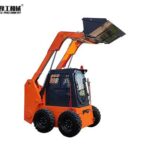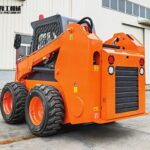Mini loader skid steer is a small, engineered to offer high maneuverability and productivity in areas where space is limited.. These machines are widely used in construction, landscaping, agriculture, material handling, and even in municipal services. The popularity stems from their compact build, powerful hydraulic system, and ability to use a wide range of attachments, making them one of the most versatile tools on any job site. Its defining characteristic is the “skid steer” mechanism, where the machine turns by driving its wheels or tracks at different speeds, enabling zero-radius turning, a feature that eliminates the need for a wide turning circle.
Features of A Mini Loader Skid Steer
- Compact Size
The reduced dimensions make it easy to operate in confined spaces, narrow alleys, and tight job sites. - Maneuverability
Skid steering allows the machine to turn within its own footprint, enhancing mobility in restricted areas. - Hydraulic Power
Strong hydraulic systems enable the small loader skid steer to lift heavy loads and power multiple attachments effectively. - Attachment Versatility
From buckets and augers to trenchers and pallet forks, these machines can switch attachments quickly, expanding their range of applications.
Applications Across Industries
The mini loader skid steer’s adaptability makes it a valuable asset in numerous sectors:
- Landscaping and Ground Maintenance
Landscapers rely on mini loaders for grading, trenching, and material handling. Their low ground pressure minimizes damage to turf, making them ideal for golf courses, parks, and residential lawns. Attachments like soil conditioners and rotary tillers further enhance their utility in soil preparation. - Construction and Demolition
In construction, mini loaders are used for moving bricks, concrete, and rebar on job sites. Their compact size allows them to operate inside buildings during renovations or demolitions. Demolition attachments like hydraulic breakers or grapples enable them to tear down walls or clear debris efficiently. - Agriculture and Forestry
Farmers use mini loaders for feeding livestock, cleaning barns, and moving hay bales. In forestry, they assist with log handling, trail maintenance, and firebreak creation. Their ability to traverse rough terrain makes them indispensable in rural settings. - Utility and Municipal Work
Utility companies deploy mini loaders for digging trenches for cables or pipes, installing street signs, or maintaining drainage systems. Municipalities use them for snow removal, road repair, and park maintenance.
Advantages of Small Loader Skid Steer
- Space-Saving: Mini loader skid steer is perfect for projects in urban environments or residential areas with limited access.
- Cost-Effective: Requires less fuel, lower maintenance costs, and typically comes at a more affordable price compared to full-sized loaders.
- Time Efficiency: Quick attachment changes save time, allowing operators to complete multiple tasks with one machine.
- Durability: Built to handle rugged environments and tough workloads.
- Ease of Transport: Due to its smaller size, this machine can be transported easily on trailers without requiring specialized hauling equipment.
Compact Loader Skid Steer Structural Components
A mini loader skid steer is built with a combination of robust and precision-engineered components:
- Engine: Provides the power to drive the hydraulic system and propel the machine.
- Hydraulic Pump and Cylinders: Drive the attachments and provide lifting force.
- Lift Arms: Connect to the attachments and support lifting operations.
- Operator Cab: Contains controls, seating, and safety features.
- Undercarriage: Equipped with wheels or tracks, offering stability and traction.
- Quick Attachment Plate: Allows fast switching between tools.
How to Choose A Mini Skid Steer Loader?
When purchasing a mini loader skid steer, consider the following factors:
- Size and Weight: Ensure the machine fits your work environment and can be transported easily.
- Engine Power: Choose the right horsepower for your intended workload.
- Hydraulic Flow: Higher flow rates allow you to operate more powerful attachments.
- Attachment Compatibility: Verify the machine can accommodate the attachments you plan to use.
- Operator Comfort: Look for user-friendly controls, visibility, and safety features.



